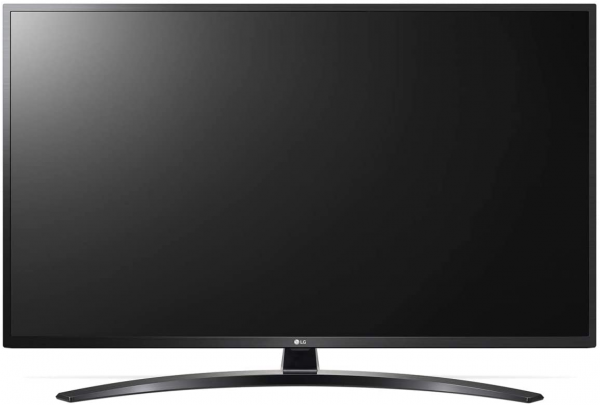LG
Nanocell 55SM8200 TV: LG does more than just Oled
Aprox. 578€
See specificationsThe LG 55SM8200 is the most affordable television in the Nanocell range from the Korean manufacturer. It uses a quantum dot filter to improve energy efficiency and coverage of the color spectrum ... at least in theory.
Positive points
User-friendly and responsive webOS system.
Very fast start-up time.
Interesting brightness peak for use in a bright room.
Reduced display delay.
Bad points
Disappointing viewing angles for an IPS TV.
Limited contrast.
Our review
Presentation
The 55SM8200 occupies the heart of the LG range. This TV has a 55-inch (approximately 140 cm) panel displaying an Ultra HD definition of 3,840 x 2,160 pixels equipped with a nanocell filter using quantum dots to improve color rendering and improve the angles of vision. The native refresh rate is limited to 50 Hz and it uses an Edge-Led backlight system composed of a single bar at the base of the panel. On the audio system side, this model has two 10 W speakers. It is powered by the WebOS system in its latest version 4.5 accompanied by the Magic Remote.
The LG 55SM8200 TV is sold for around € 900, but it's fairly easy to find it around € 700. It is also available in a 49-inch version (49SM8200, about 125 cm) for around € 600 and in a 65-inch version (65SM8200, about 165 cm) for € 1,200.
All the brightness and colorimetric measurements mentioned in this article were carried out with a SpectraCal C6-HDR probe and the CalMAN Ultimate software.
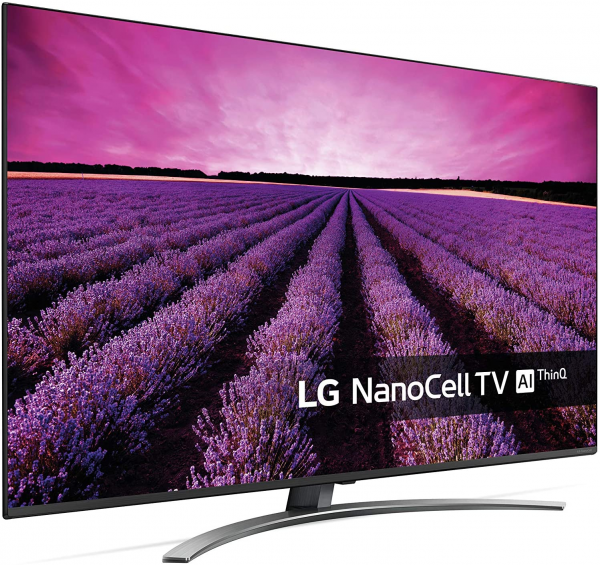
Image quality
The chevron-shaped sub-pixels confirm the use of an IPS-type LCD panel. This technology improves viewing angles, but it produces less contrast than a VA panel. However, the results are far from perfect since we have measured a variation in brightness of 65% at 45 °, almost as much as on a VA panel (70%). This is very far from what Oled technology offers with only 25% variation at 45 °. IPS technology - supposed to offer very good viewing angles - has clearly disappointed us on this TV.
As often, it is the Cinema mode which allows to obtain the most faithful rendering. In this mode, we measured a delta E of only 3.1. The colors cannot be considered as perfect, but the colorimetric drift remains controlled, knowing that the average is not very far from the threshold of 3 below which the eye no longer differentiates between the ideal colors and the displayed colors.
Adjusted to the BT.1886 standard, the gamma displays an average of 2.13, but above all it benefits from a stable curve over most of the spectrum. Grayscale is therefore fairly well represented, with the exception of light gray, slightly overexposed.
The temperature curve is stable over the entire spectrum and the average measured at 6,410 K is very close to 6,500 K of the video standard. It is flawless on this point.
Unsurprisingly, the contrast of 890: 1 is very limited and results in faded blacks that appear gray. The 55SM8200 tries to play on dynamic brightness to improve contrast - with no apparent success. The white measured at 148 cd / m² on our 35% goes thus to 87 cd / m² on our target containing 1% of white, that is to say an average of 118 cd / m² on white and 0.13 cd / m² on black. For use in broad daylight or in a fully lit room, this low contrast is not a problem. It is much more so in the dark or in the dark when watching a film or TV series.
The scaling engine allows you to resize SD, HD and Full HD content so that they display correctly on this Ultra HD panel. This engine is very soft and smooths out many textures. It does not distort the original source and we have not observed any artifacts. This processor is more limited than the Alpha 7 and the Alpha 9 found on more high-end televisions from the same manufacturer.
On the motion compensation side, the TruMotion motor does its best to limit jerks, but it cannot improve sharpness in the absence of a 100 Hz panel. The 50 Hz prevents the insertion of black images via the backlight scanning.
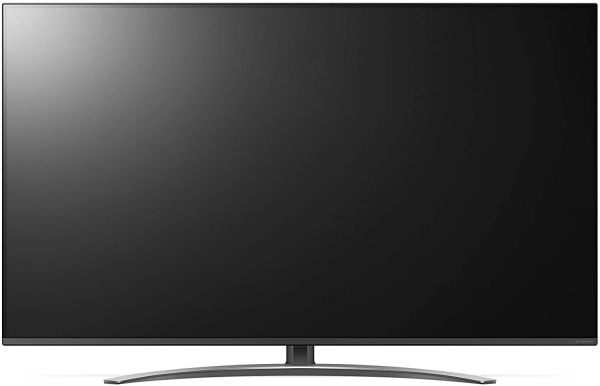
HDR
The LG 55SM8200 is compatible with the HDR10 used by the PS4 and Xbox One consoles as well as films (Blu-ray Ultra HD and online streaming Netflix, Amazon Prime, etc.) and HLG (Hybrid Log Gamma), adopted HDR standard by television channels. On the other hand, it ignores compatibility with the dynamic metadata formats HDR10 + and Dolby Vision, which are however the most interesting on this type of television very limited in processing power.
While LG's Display Tone Mapping is flawless on the promise Oled TVs, this is not the case on this Nanocell model. Up to 65% luminance, the TV delivers an image that is too bright compared to the reference signal. However, it then smooths the signal perfectly up to the maximum capacity of the panel.
Measured at 580 cd / m², the peak of brightness makes it possible to display a fairly bright image in HDR. This is an interesting peak for a TV in this price range. Too bad the low contrast limits the overall dynamics of the image which cannot display deep blacks.
HDR Cinema mode always offers the best color rendering. We measured an average delta E of 4.4, a figure slightly higher than the threshold of 3. Above all, some shades exceed a delta E of 6, resulting in colors a little distant from the original colors.
The LG 55SM8200 television only covers 61% of the Rec. 2020 space, a fairly low figure which does not allow the colors of this space to be reproduced. Recall that even high-end televisions are currently content with 70 to 75% coverage of Rec. 2020.
In the same way, the coverage of the DCI-P3 color space is quite limited with only 81% of the covered space while Oled televisions display more than 90% of the colors of the DCI-P3. It is this space that is still mainly used today for 4K Ultra HD productions.
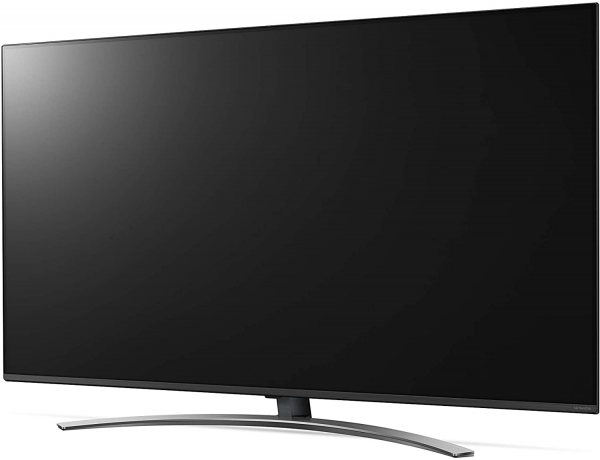
Video games
The remanence time measured at 18 ms is very far from that of the best LCDs on the market, such as the Samsung QE65Q85R and Sony KD-75XG9505 which drop to 11 ms. It corresponds to that of entry-level televisions like the Samsung UE55RU7405 which also displays a remanence time of 18 ms. We can therefore perceive a trail behind moving objects (ghosting).
Game mode reduces the display delay to just 14.4 ms. An excellent value which results in less than one image of delay compared to the source (at 60 Hz). In practice, there is almost no lag between the action on the joystick and its impact on the screen.
After restoring the temperature to a more correct value (Image settings> Expert control> White balance> Temperature> Effect 1), we measured a delta E at 3.3 in game mode, a value just above the threshold of 3 and which results in fairly fair colors.
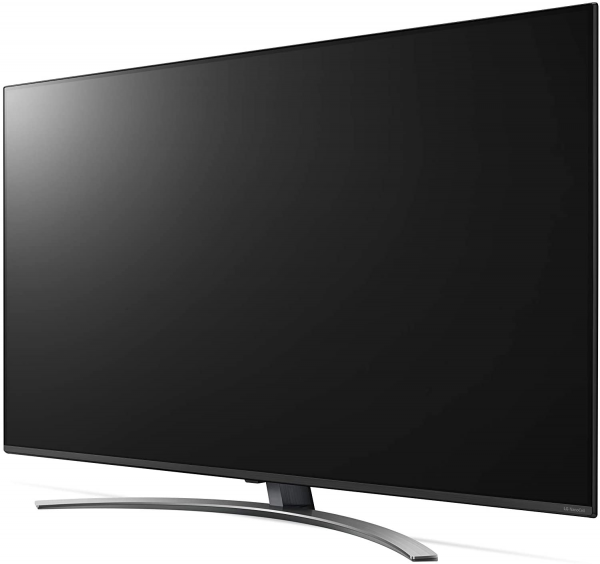
Clouding
The LG 55SM8200 uses an Edge-Led backlight system which only has one backlight bar located at the base of the panel. If we did not find clouding problems on the model we tested, the risk is present, because the diffusion filter is fragile and can be damaged during transport. This results in the appearance of grayish spots on a uniform background. Finally, we did not notice any light leakage on our test model; on the other hand, vertical blooming is sometimes annoying, especially on the subtitles, and more generally on all light objects on a black background.
The average difference in white homogeneity over the entire slab is measured at 12% - the eye does not detect anything below 20%; this is a good figure for a 55 inch LCD TV using an Edge-Led system.
Ergonomics
The LG 55SM8200 TV is fairly standard. The design is very versatile with a fairly well finished black frame and an aluminum finish at the base of the slab.
The arched foot is the signature of LG on some of its televisions and monitors. If this stand is airy enough and visually frees up space on the TV stand, it protrudes a lot in front of the screen.
The treatment of the slab is rather effective against reflections. If it does not do as well as high-end TVs from Samsung - real benchmarks on this criterion -, this TV filters out reflections almost as well as Oled models, which is already a small feat for a TV in this range.
In profile, the thickness is measured at 6.3 cm. The size on the TV stand is in any case always linked to that of the stand, which here shows a depth of 26.3 cm. It is also 84 cm wide. Unsurprisingly, this TV is comfortable on our benchmark TV stand (160 x 40 cm).
The frame around the screen is quite thin, especially for a 55-inch model, and the assembly is well done. Overall, the finishes are very good.
The back of the TV is well finished. The ribbed plastic gives a premium side. You can also see the mounting holes for wall support in VESA 300 x 300 format.
The connection consists of four HDMI 2.0 inputs HDCP 2.2 and HDR compatible, two USB 2.0 ports, an optical digital audio output, a composite / component input, an Ethernet port, a PCMCIA port (Common Interface CI +) and the aerials TNT / cable and satellite. This television embeds a DVB-T / T2 / C / S / S2 tuner as well as Wi-Fi and Bluetooth. However, it ignores the headphone output.
The webOS system in this version 4.5 is much more sober. The vertical strip disappears and the lower strip now groups all of the applications. It is possible to let the system intelligently manage the layout of applications, which are then classified according to their frequency of use (the most used on the left, those which are the least on the right). The set is still as pleasant to use and LG has worked particularly on the fluidity. The main applications are available (Netflix, YouTube, Amazon Prime, Google Play Films, BeIn, Spotify, OCS or Deezer), but a few are still missing (notably My Canal). They launch quickly and remain in memory for a rapid recovery. WebOS 4.5 includes the Google Assistant voice assistant (microphone button) associated with the LG ThinQ AI layer as well as Amazon's Alexa voice assistant (long press on the Prime Video button). The LG ThinQ AI overlay can fetch content on many online platforms and will also adjust its responses to suit your tastes. The Amazon Alexa ecosystem is very rich, you will be able to order all the devices compatible with the Amazon assistant (bulbs, sockets, thermostats, cameras, speakers, robots, etc.). Finally, like last year, voice controls offer the possibility of carrying out searches and controlling the television ("put such a channel", "record such a program", etc.), change the settings (switch to Game mode, in Cinema mode , etc.) and many more. However, this TV is not AirPlay 2 or Homekit compatible, like the manufacturer's Oled TVs.
LG's webOS system is still as responsive as ever. The first ignition is done in just 4 seconds and the recovery is done almost instantly in just 2 seconds. The extinction is always immediate.
Like the Oled models, the LG 55SM8200 TV is supplied with the Magic Remote. We find the Netflix and Amazon Prime keys as well as the Quick Access button (0 key). Thanks to its very low center of gravity, it fits effortlessly in the palm of the hand. The gyroscope works wonderfully, as does the built-in microphone allowing voice searches. The remote control offers all the usual controls and two multimedia keys (play and pause). Unfortunately, the keys are still not backlit.
Audio
The LG 55SM8200 is satisfied with two 10 W speakers which nevertheless deliver a very correct sound. With the exception of a slight dip around 4000 Hz, the audio system covers the entire spectrum properly. Obviously, fans of films and series wanting to enjoy a better immersion will turn to a sound bar, a home theater kit or even a PC speaker kit.
Consumption
We measured consumption at 75 W on our target with a white set at 150 cd / m². The relative consumption is therefore 90 W / m², which is slightly lower than the average of the televisions tested (around 100 W / m²). This television consumes more than other televisions equipped with an Edge-Led backlight system and it is very far from the best in the category, such as the Samsung QE65Q60R with 66.1 W / m², the TCL 55DC760 with 66 W / m² or again the Sony KD-65XG8505 - the most economical television in our comparison - which is content with a consumption of 55.8 W / m². Standby consumption is always less than 1 W.
Conclusion
The LG 55SM8200 is a good TV, nothing more. It does everything fairly well, but does not excel in any area, with the exception of the low display delay which allows for excellent responsiveness in video games. Note all the same the presence of the webOS system, still as fluid and pleasant to use.
Specifications

